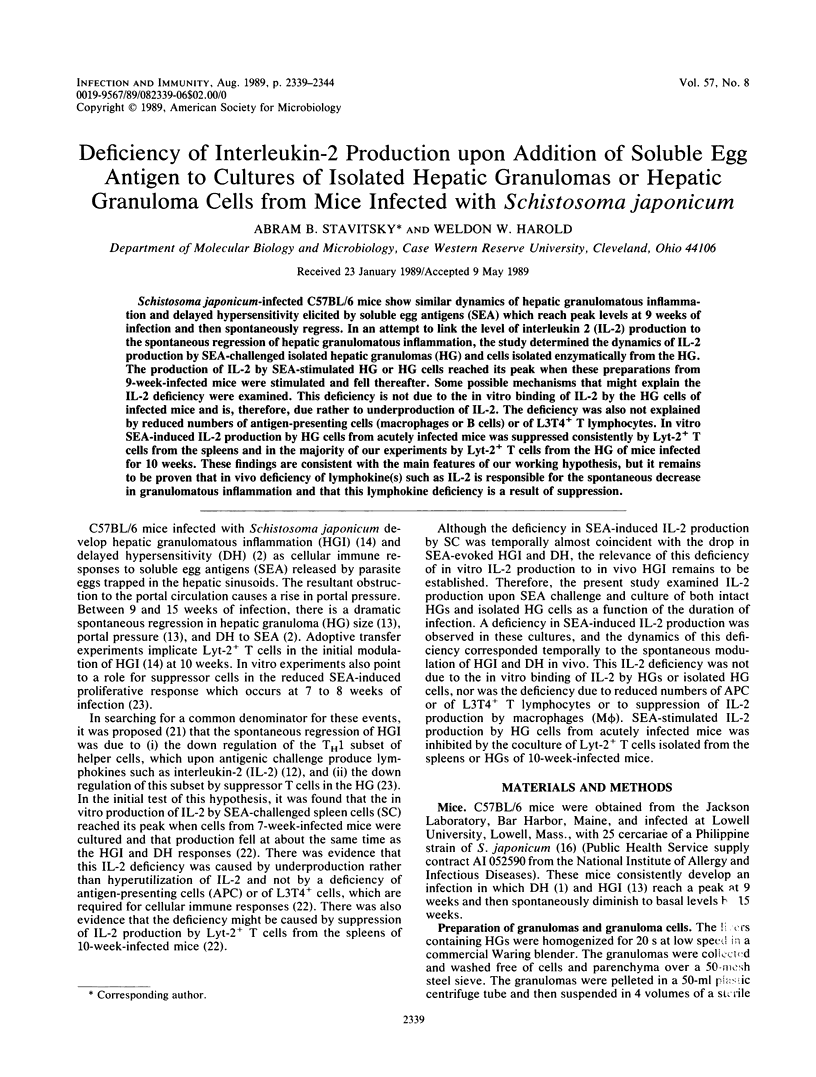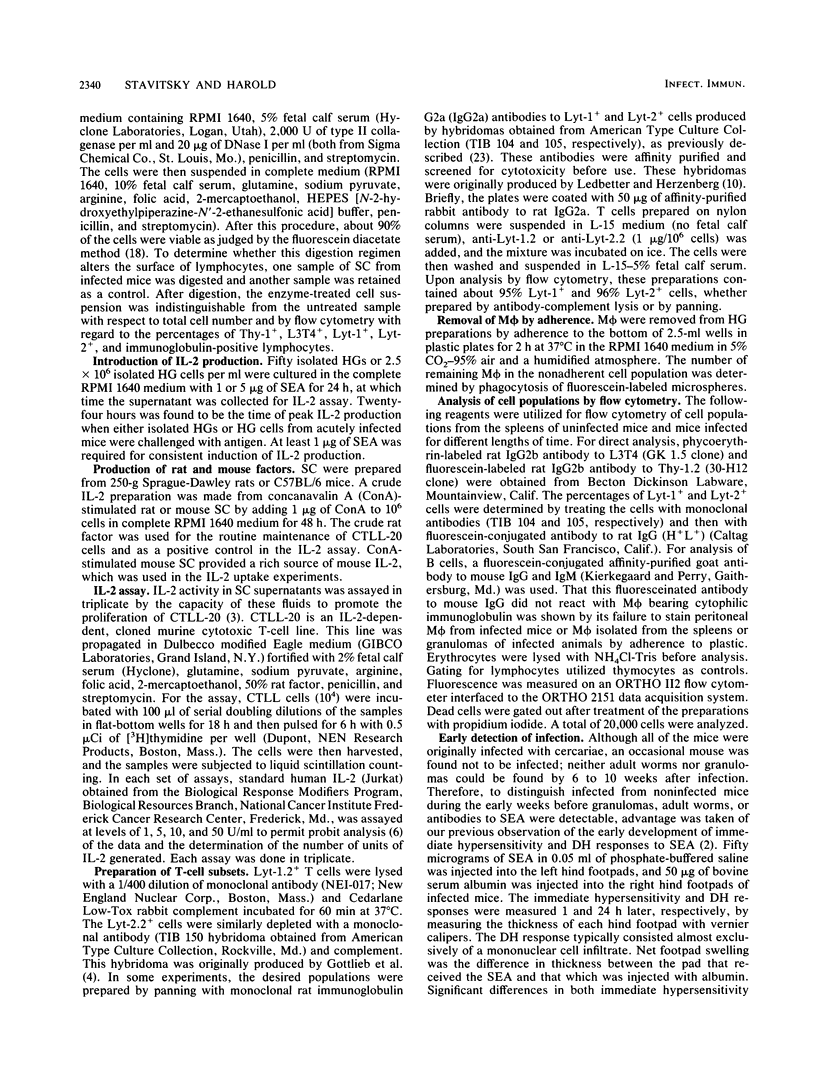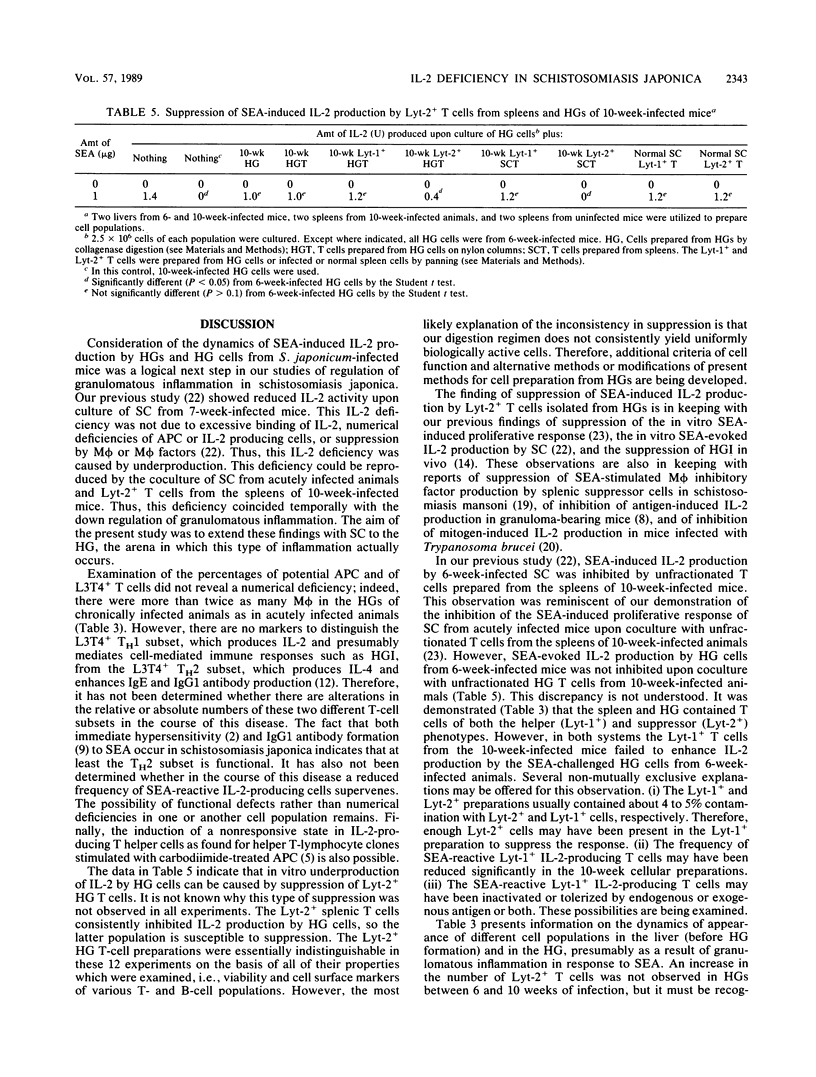Abstract
Schistosoma japonicum-infected C57BL/6 mice show similar dynamics of hepatic granulomatous inflammation and delayed hypersensitivity elicited by soluble egg antigens (SEA) which reach peak levels at 9 weeks of infection and then spontaneously regress. In an attempt to link the level of interleukin 2 (IL-2) production to the spontaneous regression of hepatic granulomatous inflammation, the study determined the dynamics of IL-2 production by SEA-challenged isolated hepatic granulomas (HG) and cells isolated enzymatically from the HG. The production of IL-2 by SEA-stimulated HG or HG cells reached its peak when these preparations from 9-week-infected mice were stimulated and fell thereafter. Some possible mechanisms that might explain the IL-2 deficiency were examined. This deficiency is not due to the in vitro binding of IL-2 by the HG cells of infected mice and is, therefore, due rather to underproduction of IL-2. The deficiency was also not explained by reduced numbers of antigen-presenting cells (macrophages or B cells) or of L3T4+ T lymphocytes. In vitro SEA-induced IL-2 production by HG cells from acutely infected mice was suppressed consistently by Lyt-2+ T cells from the spleens and in the majority of our experiments by Lyt-2+ T cells from the HG of mice infected for 10 weeks. These findings are consistent with the main features of our working hypothesis, but it remains to be proven that in vivo deficiency of lymphokine(s) such as IL-2 is responsible for the spontaneous decrease in granulomatous inflammation and that this lymphokine deficiency is a result of suppression.
Full text
PDF





Selected References
These references are in PubMed. This may not be the complete list of references from this article.
- Chensue S. W., Boros D. L., David C. S. Regulation of granulomatous inflammation in murine schistosomiasis. In vitro characterization of T lymphocyte subsets involved in the production and suppression of migration inhibition factor. J Exp Med. 1980 Jun 1;151(6):1398–1412. doi: 10.1084/jem.151.6.1398. [DOI] [PMC free article] [PubMed] [Google Scholar]
- Farrar W. L., Birchenall-Sparks M. C., Young H. B. Interleukin 2 induction of interferon-gamma mRNA synthesis. J Immunol. 1986 Dec 15;137(12):3836–3840. [PubMed] [Google Scholar]
- Garb K. S., Stavitsky A. B., Mahmoud A. A. Dynamics of antigen and mitogen-induced responses in murine schistosomiasis japonica: in vitro comparison between hepatic granulomas and splenic cells. J Immunol. 1981 Jul;127(1):115–120. [PubMed] [Google Scholar]
- Gillis S., Ferm M. M., Ou W., Smith K. A. T cell growth factor: parameters of production and a quantitative microassay for activity. J Immunol. 1978 Jun;120(6):2027–2032. [PubMed] [Google Scholar]
- Jenkins M. K., Pardoll D. M., Mizuguchi J., Chused T. M., Schwartz R. H. Molecular events in the induction of a nonresponsive state in interleukin 2-producing helper T-lymphocyte clones. Proc Natl Acad Sci U S A. 1987 Aug;84(15):5409–5413. doi: 10.1073/pnas.84.15.5409. [DOI] [PMC free article] [PubMed] [Google Scholar]
- Jordan G. W. Basis for the probit analysis of an interferon plaque reduction assay. J Gen Virol. 1972 Jan;14(1):49–61. doi: 10.1099/0022-1317-14-1-49. [DOI] [PubMed] [Google Scholar]
- Kawabata M., Hosaka Y., Kumada M., Matsui N., Kobayakawa T. Thymocytotoxic autoantibodies found in mice infected with Schistosoma japonicum. Infect Immun. 1981 May;32(2):438–442. doi: 10.1128/iai.32.2.438-442.1981. [DOI] [PMC free article] [PubMed] [Google Scholar]
- Kobayashi K., Allred C., Yoshida T. Mechanisms of suppressed cell-mediated immunity and impaired antigen-induced interleukin 2 production in granuloma-bearing mice. J Immunol. 1985 Nov;135(5):2996–3003. [PubMed] [Google Scholar]
- Kresina T. F., Olds G. R. Concomitant cellular and humoral expression of a regulatory cross-reactive idiotype in acute Schistosoma japonicum infection. Infect Immun. 1986 Jul;53(1):90–94. doi: 10.1128/iai.53.1.90-94.1986. [DOI] [PMC free article] [PubMed] [Google Scholar]
- Ledbetter J. A., Herzenberg L. A. Xenogeneic monoclonal antibodies to mouse lymphoid differentiation antigens. Immunol Rev. 1979;47:63–90. doi: 10.1111/j.1600-065x.1979.tb00289.x. [DOI] [PubMed] [Google Scholar]
- Mathew R. C., Boros D. L. Anti-L3T4 antibody treatment suppresses hepatic granuloma formation and abrogates antigen-induced interleukin-2 production in Schistosoma mansoni infection. Infect Immun. 1986 Dec;54(3):820–826. doi: 10.1128/iai.54.3.820-826.1986. [DOI] [PMC free article] [PubMed] [Google Scholar]
- Olds G. R., Olveda R., Tracy J. W., Mahmoud A. A. Adoptive transfer of modulation of granuloma formation and hepatosplenic disease in murine schistosomiasis japonica by serum from chronically infected animals. J Immunol. 1982 Mar;128(3):1391–1393. [PubMed] [Google Scholar]
- Olds G. R., Stavitsky A. B. Mechanisms of in vivo modulation of granulomatous inflammation in murine schistosomiasis japonicum. Infect Immun. 1986 May;52(2):513–518. doi: 10.1128/iai.52.2.513-518.1986. [DOI] [PMC free article] [PubMed] [Google Scholar]
- Owhashi M., Maruyama H., Nawa Y. Eosinophil chemotactic lymphokine produced by egg-associated granulomas in murine schistosomiasis japonicum. Infect Immun. 1986 Dec;54(3):723–727. doi: 10.1128/iai.54.3.723-727.1986. [DOI] [PMC free article] [PubMed] [Google Scholar]
- Reiner N. E., Finke J. H. Interleukin 2 deficiency in murine Leishmaniasis donovani and its relationship to depressed spleen cell responses to phytohemagglutinin. J Immunol. 1983 Sep;131(3):1487–1491. [PubMed] [Google Scholar]
- Rotman B., Papermaster B. W. Membrane properties of living mammalian cells as studied by enzymatic hydrolysis of fluorogenic esters. Proc Natl Acad Sci U S A. 1966 Jan;55(1):134–141. doi: 10.1073/pnas.55.1.134. [DOI] [PMC free article] [PubMed] [Google Scholar]
- Sileghem M., Hamers R., De Baetselier P. Active suppression of interleukin 2 secretion in mice infected with Trypanosoma brucei AnTat 1.1.E. Parasite Immunol. 1986 Nov;8(6):641–649. doi: 10.1111/j.1365-3024.1986.tb00877.x. [DOI] [PubMed] [Google Scholar]
- Stavitsky A. B., Harold W. W. Deficiency of interleukin-2 activity upon addition of soluble egg antigen to cultures of spleen cells from mice infected with Schistosoma japonicum. Infect Immun. 1988 Jul;56(7):1778–1784. doi: 10.1128/iai.56.7.1778-1784.1988. [DOI] [PMC free article] [PubMed] [Google Scholar]
- Stavitsky A. B., Olds G. R., Peterson L. B. Regulation of egg antigen-induced in vitro proliferative response by splenic suppressor T cells in murine Schistosoma japonicum infection. Infect Immun. 1985 Sep;49(3):635–640. doi: 10.1128/iai.49.3.635-640.1985. [DOI] [PMC free article] [PubMed] [Google Scholar]
- Tarleton R. L., Kuhn R. E. Restoration of in vitro immune responses of spleen cells from mice infected with Trypanosoma cruzi by supernatants containing interleukin 2. J Immunol. 1984 Sep;133(3):1570–1575. [PubMed] [Google Scholar]
- Walker C., Kristensen F., Bettens F., deWeck A. L. Lymphokine regulation of activated (G1) lymphocytes. I. Prostaglandin E2-induced inhibition of interleukin 2 production. J Immunol. 1983 Apr;130(4):1770–1773. [PubMed] [Google Scholar]
- Yamashita T., Watanabe T., Sendo F. Studies on the immunological disturbance in murine schistosomiasis japonica from the viewpoint of the interleukin cascade reaction. Immunology. 1987 Oct;62(2):215–221. [PMC free article] [PubMed] [Google Scholar]


